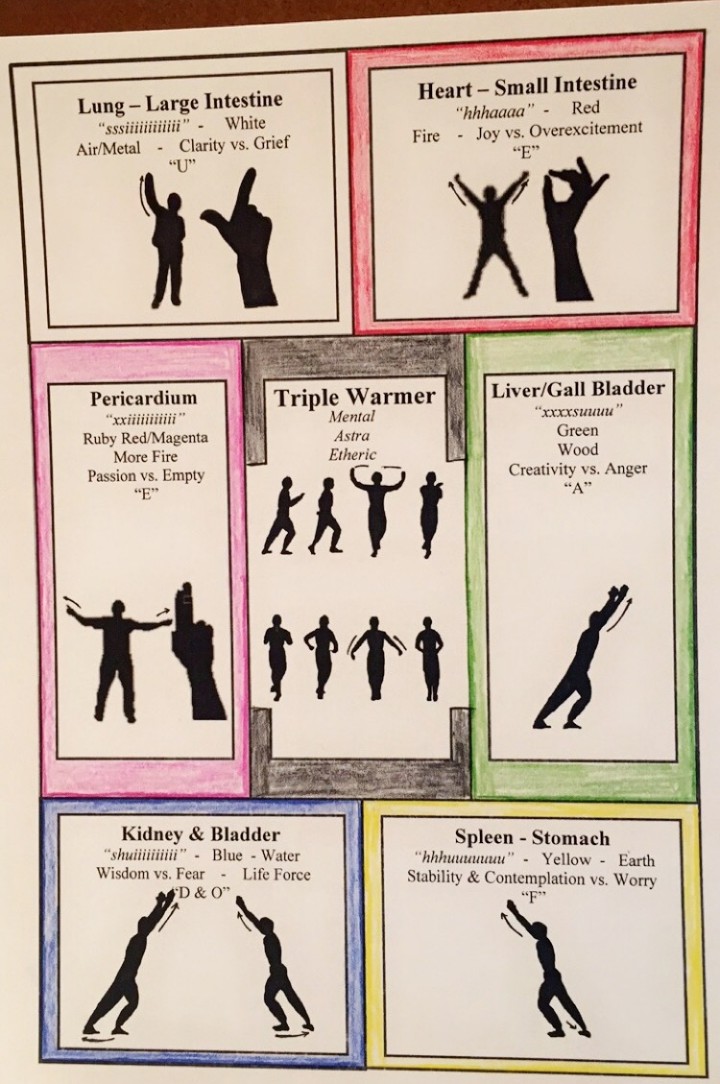Tao Yin Fa
We are beginning to go over these series of movements in the Wednesday morning Qi Gong class. These movements circulate Qi into the meridians and the organs they nourish, balance, and keep healthy. These movements are based on “The Law of the Five Elements” and the internal energy channels known as the acupuncture meridians. They are balanced with a color, a sound, a hand position (Mudra, for sacred hand position), and a movement. It is fluid and graceful and gentle movement, meant to dance with the Universal Qi and the personal Qi.
If you would like to begin this begin this practice at home, just set aside some time. You can begin to get familiar with this any way you’d like. For example…
1st Sitting: Read through the sequence a few times, imagining the color and making the sound while doing the hand mudra, and practice deep Dan Tien breathing.
More on Dan Tien breathing from Kenneth S. Cohen’s, The Way of Qi Gong:
“Dan Tian Breathing is an extremely beneficial variation of natural breathing. The dan tien is the energy center in the abdominal region, about three inches below the navel and midway into the center of the body. The precise location of the dan tian can vary slightly from individual to individual. Some students feel it behind the navel, others locate it closer to the pubic bone. Listen to how your body breathes. The dan tian will be the point or region from which the expansion of the abdomen seems to originate.
When practicing dan tien breathing, both the lower abdomen and the lower back expand with inhalation, and both retract with exhalation. Most of the movement is still felt in the front of the body, but there is definitely a response in the back. If you were to hold your hands on the lower abdomen and lower back of a qigong master during inhalation, you would feel as if a small balloon were expanding in the abdomen and pushing both hands away from each other. The lower spine pushes lightly into your palm and the kidneys seem to expand with a gentle outward and lateral movement. During exhalation, air is let out of the balloon and the hands sink towards each other.
Dan Tian Breathing includes all of the benefits of natural respiration. It makes the mind and body relaxed, decreases unhealthy reactions to stress, lessens anxiety, allows more efficient gaseous exchange, and massages internal organs. Dan Tien Breathing primes the body’s major energetic pump so that qi can spread more efficiently throughout the body.”
2nd Sitting: Taking it a step further, bring emotions into your breathing. Still seated, using the chart below and steps from the first sitting, start to breath in the benefits of the color to the meridian organ and exhale the negative aspect of the blocked meridian in order to open things up. For example, when focusing on the liver/gall bladder, inhale kindness and exhale anger.
3rd Sitting: Follow the steps from the first and second sitting, only this time do so standing. Just remember the keys to standing meditation:
- Feet shoulder width apart, feel the bottom of your feet on the Earth
- Relaxed, soft knees
- Arms at your side or forming a circle in front of the body, with everything relaxed, from your shoulders to your fingertips
- Let go of any tension in the shoulders
- Relax the neck, slightly tuck the chin, let the eyes soften and focus on a point on the floor roughly three feet in front of you
Remember to soften the Dan Tien and practice Dan Tien Breathing!
Here is a chart outlining the movements.




